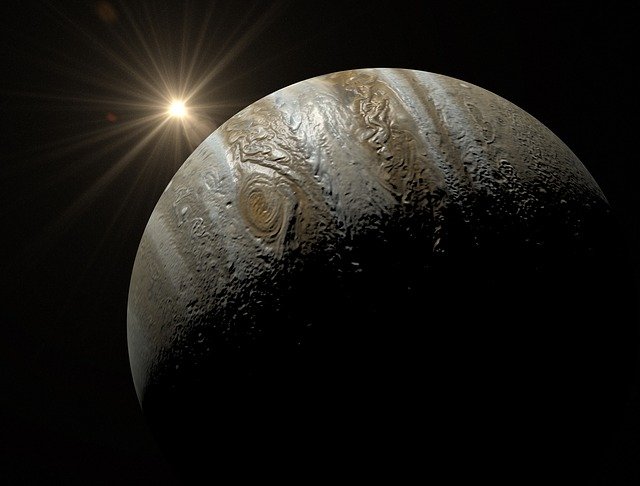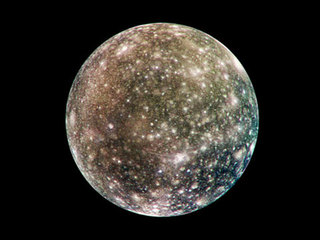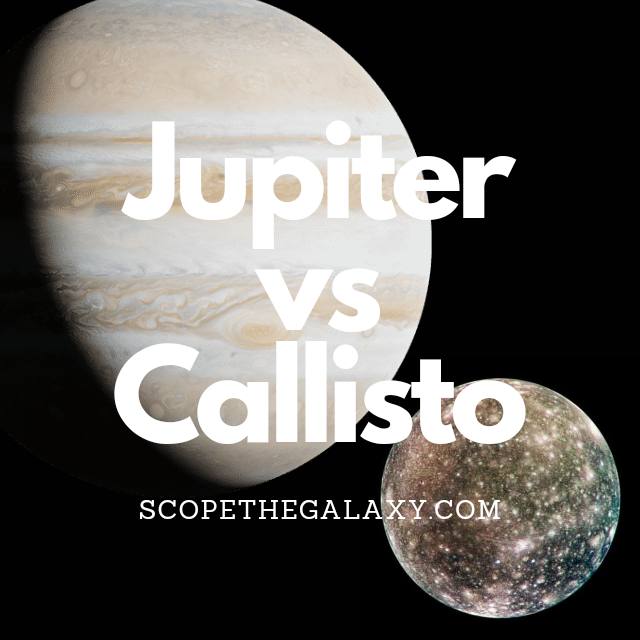*This post may contain affiliate links. This means we may make a commission if you purchase an item using one of our links*
The main differences between Jupiter and Callisto is that Jupiter is the biggest planet in the solar system whilst Callisto is the 3rd biggest Moon, Callisto orbits Jupiter whilst Jupiter has 79 moons orbiting it, Jupiter is a gas giant composed of helium and hydrogen whilst Callisto is a low density terrestrial based entity with a surface full of craters whilst Jupiter does not.
There are numerous other differences between the two so, continue reading for a more detailed look at each celestial body, along with their similarities and differences.
What Is The Planet Jupiter?
Table of Contents

Jupiter is the 5th farthest planet from the Sun and the largest planet within our local solar system. The planets most recognizable trait is the giant red spot visible on its atmosphere along with the brown horizontal bands flowing across its atmosphere.
As a result of its composition and size, Jupiter falls under the classification of a gas giant.
This is because its composition mostly consists of the elements hydrogen and helium. The split is roughly 71% hydrogen, 27% helium, with the remainder of the elements split throughout the left over 2%.
As the biggest planet in our solar system, Jupiter is 139,820 km or 1,300 Earths in diameter, it has a mass of around 0.001 solar masses, the temperature when inside the clouds are roughly -145 degrees Celsius whilst the core is far hotter, equating in the region of 24,000 degrees Celsius.
Due to its extreme circumstances, gaseous composition and distance from the Sun, the planet is not theoretically capable to support life, from its subzero temperature to the extremely fast 640 km/h winds, and its gravity which may be unsustainable for our bones, roughly 2.4 times greater than Earth’s.
Although the conditions on Jupiter aren’t suitable for us, some of its 79 moons like Europa for example could support life.
This brown giant has a relatively fast rotation around its axis where 1 rotation typically takes 10 hours to make whilst its orbit around the Sun is far longer taking in the region of 12 years for 1 full cycle.
Another feature of Jupiter that is renowned by astronomers is the strength of its magnetic field. In comparison to the other planets in our solar system it is even stronger than our Sun, where it’s over magnetosphere is roughly 20,000 times the strength of Earth.
What this means is that Jupiter’s magnetosphere is able to avert solar winds that are 3 million kilometers away from it.
What Is The Moon Callisto?

Callisto is one of the large moons orbiting Jupiter, the outermost of the Galilean moons, first discovered on 7th January 1610. The surface of this icy world is frozen, but scientists believe an underground ocean could reside beneath the ice.
Even if there’s water on Callisto, it won’t necessarily hold life because the surface is so old. Scientists will need to conduct more research into the moon before determining whether this is a likely possibility.
The ESA’s JUICE (Jupiter Icy Moon Explorer) mission is focused on the three ice moons of Jupiter. It is expected to arrive in 2030 and will focus on learning more about the environment of each, as well as their potential for hosting life.
Scientists estimate that Callisto is around 4.5 billion years old (the same age as Jupiter), and its average distance from the Sun is approximately 778 million km. It has a diameter of 4820.6km, which makes it similar in size to the planet Mercury, and the average temperature is a frigid minus 139.2 degrees Celsius.
Callisto takes seven days to orbit its planet at an average distance of 1,880,000km, and it is tidally locked, meaning the same side of it always faces Jupiter. But this moon experiences less tidal influence than the other Galilean moons because it lies in the orbit of Jupiter’s primary radiation belt.
The name of this moon is derived from the stories of Greek myth. Callisto was the nymph who had an affair with Zeus, the King of the Gods. Upon hearing this news, Zeus’ wife Hera turned Callisto into a star and placed her in the Ursa Major constellation. Interestingly, every moon of Jupiter is named after a Greek figure who Zeus seduced.
Callisto may be the third biggest moon and similar in size to the planet Mercury, but it only has a mass of 107,593,737,963.819 billion kg. That may sound like a lot, but it’s only ⅓ the mass of the similarly sized Mercury.
You may wonder why scientists classify Callisto as a “moon” rather than a planet if it’s almost the same size as Mercury. The reason is simple; planets must orbit the sun, but Callisto orbits one of the planets.
The composition of this frigid world is around 60% rock and iron and 40% ice. The moon has roughly equal amounts of rock and ice, plus the potential for water below the surface. There are also traces of carbon dioxide, organic compounds, and silicates.
This moon is one of the oldest landscapes in the Milky way and the most heavily cratered body in our system. However, scientists believe this could now be a “dead” moon as there are no longer any signs of volcanism or plate tectonics on its surface.
Similarities Between Jupiter And Callisto
There are a few similarities that Jupiter and Callisto share, which in this case includes the following:
- Both are a spherical shape.
- Both have a hotter core.
- Both are part of the same solar system.
- Neither have tectonic plates.
- Both orbit another object.
- Both orbit the Sun in 12 years.
Differences Between Jupiter And Callisto
In regards to the differences between the two, they include the following:
- Jupiter is the bigger of the two with a diameter of 139,820km compared to Callisto’s diameter of 4,820.6km.
- Jupiter has the most powerful magnetosphere in our solar system whilst Callisto does not.
- Just has 79 moons orbiting it whilst Callisto has 0 objects orbiting it.
- Callisto orbits Jupiter in an elliptical pattern whilst Jupiter orbits the Sun in an almost circular pattern.
- Callisto is tidally locked to Jupiter whilst Jupiter isn’t tidally locked to any other object.
- Jupiter has an atmosphere composed of hydrogen and helium whilst Callisto has a very thin carbon dioxide based exosphere.
- Callisto is one of the most heavily catered entities in our solar system where it has 142 named craters with a lot more smaller one scattered throughout the moon whilst Jupiter is a gas giant therefore, it doesn’t have solid surface for craters to form on.
- A day on Callisto takes 17 days whilst Jupiter completes a day in 10 hours.
- Callisto’s density is 1.83 g/cm³ whilst Jupiter’s density is 1.33 g/cm³.
- In regards to axial tilt, Jupiter’s is 3 degrees whilst Callisto’s is practically 0 degrees.
- Jupiter’s average temperature is -145 degrees Celsius whilst Callisto’s temperature is -139.2 degrees Celsius.
- As for mass, Callisto’s is 1.07 x 10^23kg whilst Jupiter’s mass is 1.898 × 10^27 kg.
- Jupiter is a gas giant whilst Callisto is a low density terrestrial entity.
- Jupiter has 4 rings surrounding it whilst Callisto has 0.
- Jupiter’s gravitational strength is 24.79 m/s² whilst Callisto’s is 1.236 m/s².
Summary
As a whole, other than the fact Callisto is one of Jupiter’s Galilean moons, the two really don’t have very much that is comparable.
Whether it be in regards to size, mass, density, their physical composition and more, Callisto and Jupiter and very much different entities and as result the manner in which they function is very much distinct from one another.

